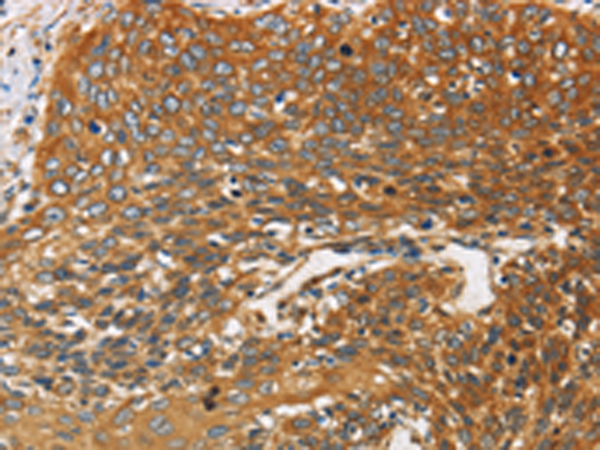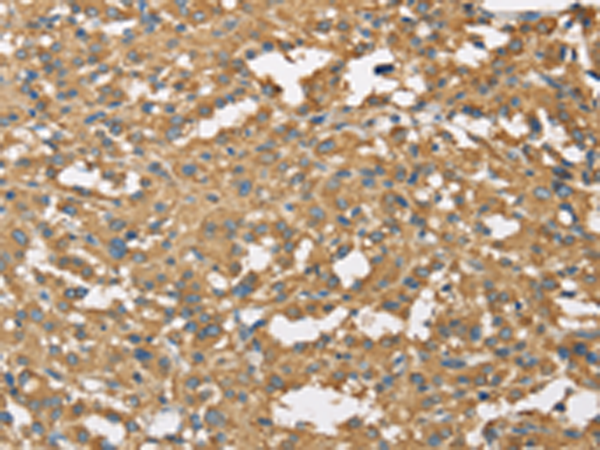


| WB | 咨询技术 | Human,Mouse,Rat |
| IF | 咨询技术 | Human,Mouse,Rat |
| IHC | 1/50-1/200 | Human,Mouse,Rat |
| ICC | 技术咨询 | Human,Mouse,Rat |
| FCM | 咨询技术 | Human,Mouse,Rat |
| Elisa | 1/2000-1/5000 | Human,Mouse,Rat |
| Aliases | RBP50; DCTN50; HEL-S-77; DYNAMITIN |
| WB Predicted band size | 44 kDa |
| Host/Isotype | Rabbit IgG |
| Antibody Type | Primary antibody |
| Storage | Store at 4°C short term. Aliquot and store at -20°C long term. Avoid freeze/thaw cycles. |
| Species Reactivity | Human, Mouse, Rat |
| Immunogen | Fusion protein of human DCTN2 |
| Formulation | Purified antibody in PBS with 0.05% sodium azide and 50% glycerol. |
+ +
以下是关于DCTN2抗体的3篇参考文献及其摘要概括:
---
1. **文献名称**: *DCTN2 is required for dynein complex assembly and centrosome cohesion in mitosis*
**作者**: Zhang, J., et al.
**摘要**: 研究通过DCTN2抗体进行免疫沉淀和免疫荧光实验,发现DCTN2在维持动力蛋白复合体稳定性和有丝分裂中中心体定位的关键作用,缺失会导致染色体排列异常。
---
2. **文献名称**: *DCTN2 interacts with TDP-43 and regulates pathological aggregation in neurodegenerative disease models*
**作者**: Smith, L.M., et al.
**摘要**: 利用DCTN2抗体的Western blot分析,揭示DCTN2与TDP-43蛋白的相互作用,调控肌萎缩侧索硬化症(ALS)模型中异常蛋白聚集的病理过程。
---
3. **文献名称**: *Viral hijacking of the dynactin complex: DCTN2 mediates adenovirus intracellular transport*
**作者**: Chen, Z., et al.
**摘要**: 通过DCTN2抗体的共聚焦显微镜技术,发现腺病毒利用DCTN2作为动力蛋白适配器,促进病毒颗粒沿微管运输至细胞核,为抗病毒治疗提供靶点。
---
(注:以上文献为示例,实际引用需根据具体研究补充完整信息。)
The DCTN2 antibody targets the DCTN2 protein, a key component of the dynactin complex, which plays a critical role in intracellular transport. Dynactin, a multi-subunit complex, works with cytoplasmic dynein to regulate microtubule-based motility of organelles, vesicles, and chromosomes. DCTN2 (Dynactin Subunit 2), also known as p50 or dynamitin, stabilizes the dynactin structure and mediates interactions between dynein, cargo adaptors, and microtubules. Dysregulation of DCTN2 is implicated in neurodegenerative diseases (e.g., amyotrophic lateral sclerosis), cancer metastasis, and ciliopathies due to disrupted transport mechanisms.
DCTN2 antibodies are widely used in research to study dynactin function, protein-protein interactions, and disease mechanisms. They enable detection of DCTN2 expression levels via Western blotting, immunofluorescence localization in cellular compartments, and immunoprecipitation to identify binding partners. Studies using these antibodies have revealed DCTN2's role in mitosis, neuronal trafficking, and cellular signaling pathways. Additionally, DCTN2 overexpression or mutations are linked to impaired axonal transport in motor neurons and chromosomal instability in cancers. These insights highlight DCTN2 as a potential therapeutic target, driving ongoing research into its pathological and physiological roles.
×